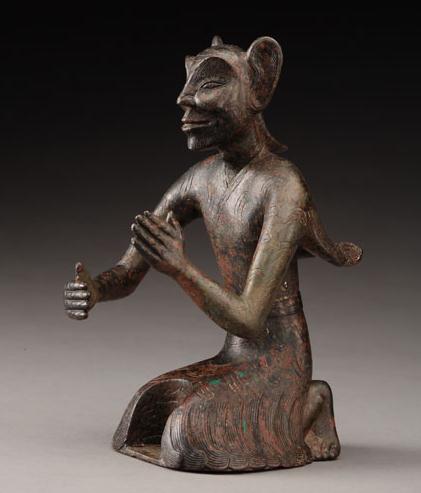The Han Dynasty to reign at Paris museum
 0 Comment(s)
0 Comment(s) Print
Print E-mail China Daily, September 24, 2014
E-mail China Daily, September 24, 2014
|
|
|
A copper statue will be displayed at the Splendors of Han, Flying of the Heavenly Empire exhibition.[Photo provided to China Daily] |
The winds of Han are expected to blow French viewers away.
The largest exhibition of Han Dynasty (206 BC-AD 220) artifacts outside China will run in Paris in celebration of the 50 years of Sino-French diplomatic ties.
Art Exhibitions China, which is in charge of Chinese relics' overseas displays, signed an agreement with Paris-based Guimet Museum last week to organize the show.
Splendors of Han, Flying of the Heavenly Empire (Splendeurs des Han, Essor de l'Empire Celeste) will exhibit 456 pieces from 27 Chinese museums from Oct 21 to March 1, 2015. Displays will include silk and gold pieces, and records written on wooden slips, Art Exhibitions China deputy director Yao An says.
The key highlight is a 1.76-meter jade burial suit unearthed in Jiangsu province's Xuzhou, she says. It's fashioned from 4,200 jade pieces and gold wire, and weighs over 1.7 kilograms. It's recognized as the finest of its kind.
"The Han Dynasty was the beginning of a unified centeral empire in China and remains the apex of ancient Chinese culture," says the display's counselor Yang Hong, who's also a researcher at the Chinese Academy of Social Sciences' Institute of Archaeology.
"It's extremely rare to see such a complete introduction, with both historical and aesthetic value, of the Han Dynasty's social structure, traditions and daily life."
The exhibition will focus on seven themes, including the political system, fine art development and communication among ethnicities.
Many artifacts are funerary.
"But visitors will be able to see accessories used while the tombs' occupants were alive," Yang says.
"This will create a continuous picture from people's lives to after their deaths."
China has exhibited cultural relics in France since the 1970s, including artifacts from Gansu province's Mogao Grottoes, Beijing's Palace Museum and Shaanxi province's Terracotta Warriors.
The upcoming exhibition's hall will be designed as a Han tomb, complete with frescos, Guimet Museum's curator Eric Lefebvre says.
"Whatever the audiences' cultural backgrounds, they'll certainly be enlightened by the exhibits," he says in fluent Chinese.
"It's a pity I didn't learn about the Han Dynasty in school. In recent years, the Han has appeared in France's history textbook. Although the introduction is brief, it ignites students' interest to learn more. The treasures displayed at the upcoming show will help French people understand Chinese culture on a deeper level."







